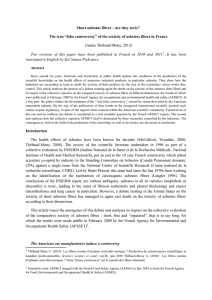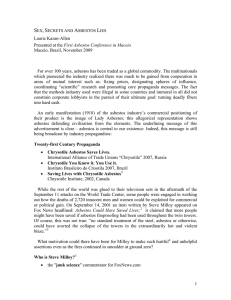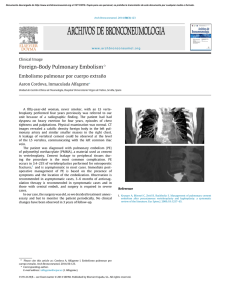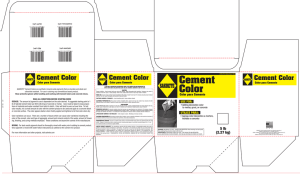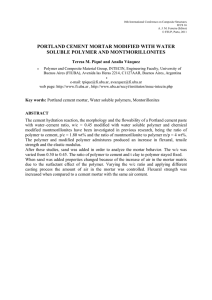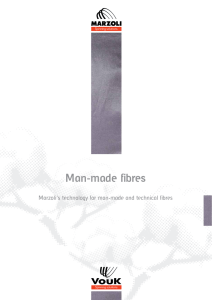Read presentation
Anuncio
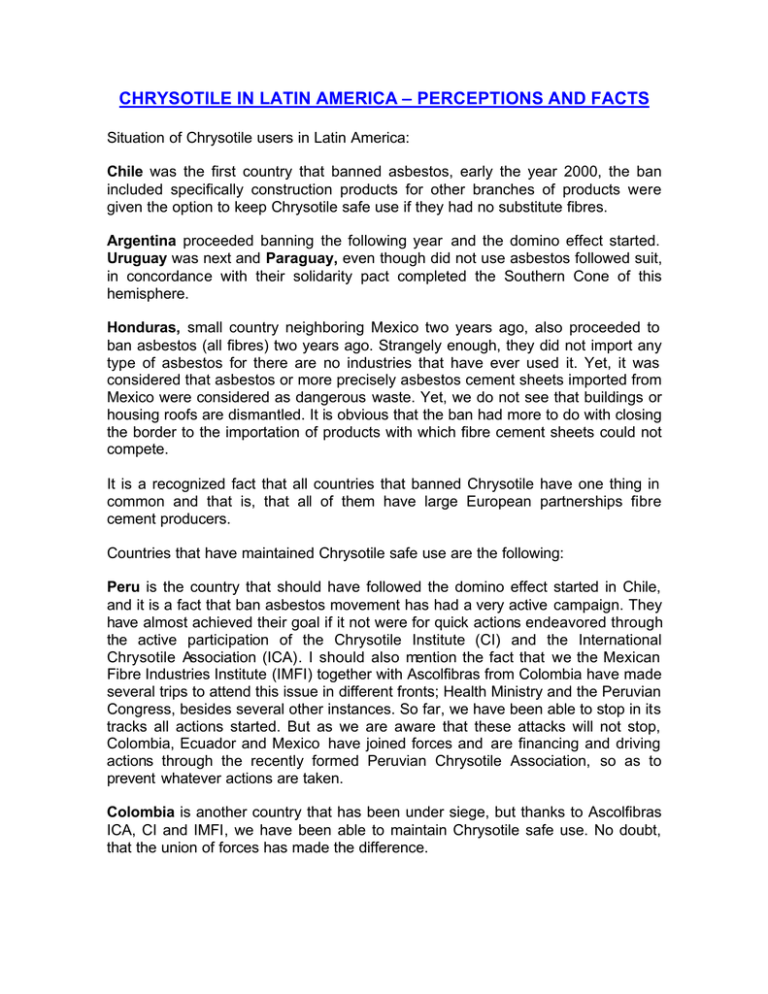
CHRYSOTILE IN LATIN AMERICA – PERCEPTIONS AND FACTS Situation of Chrysotile users in Latin America: Chile was the first country that banned asbestos, early the year 2000, the ban included specifically construction products for other branches of products were given the option to keep Chrysotile safe use if they had no substitute fibres. Argentina proceeded banning the following year and the domino effect started. Uruguay was next and Paraguay, even though did not use asbestos followed suit, in concordance with their solidarity pact completed the Southern Cone of this hemisphere. Honduras, small country neighboring Mexico two years ago, also proceeded to ban asbestos (all fibres) two years ago. Strangely enough, they did not import any type of asbestos for there are no industries that have ever used it. Yet, it was considered that asbestos or more precisely asbestos cement sheets imported from Mexico were considered as dangerous waste. Yet, we do not see that buildings or housing roofs are dismantled. It is obvious that the ban had more to do with closing the border to the importation of products with which fibre cement sheets could not compete. It is a recognized fact that all countries that banned Chrysotile have one thing in common and that is, that all of them have large European partnerships fibre cement producers. Countries that have maintained Chrysotile safe use are the following: Peru is the country that should have followed the domino effect started in Chile, and it is a fact that ban asbestos movement has had a very active campaign. They have almost achieved their goal if it not were for quick actions endeavored through the active participation of the Chrysotile Institute (CI) and the International Chrysotile Association (ICA). I should also mention the fact that we the Mexican Fibre Industries Institute (IMFI) together with Ascolfibras from Colombia have made several trips to attend this issue in different fronts; Health Ministry and the Peruvian Congress, besides several other instances. So far, we have been able to stop in its tracks all actions started. But as we are aware that these attacks will not stop, Colombia, Ecuador and Mexico have joined forces and are financing and driving actions through the recently formed Peruvian Chrysotile Association, so as to prevent whatever actions are taken. Colombia is another country that has been under siege, but thanks to Ascolfibras ICA, CI and IMFI, we have been able to maintain Chrysotile safe use. No doubt, that the union of forces has made the difference. We are not aware of anything happening in Bolivia, but a couple of months ago Ecuador was confronted with a seminar trying to achieve a ban which did not succeed thanks to important actions from industry and Ascolfibras. Brazil, has kept Chrysotile safe use thanks to a very responsible industry which is SAMA, a mine that has ISO 14000, and just last year obtain the mention from authorities as the cleanest plant in Brazil. Attacks are there but with the help of the Brazilian Chrysotile Institute, they keep on going forward as the river flows. Cuba, plants are government owned and maintain Chrysotile safe use. El Salvador, has a glow worm, in other words, industry maintains the light defending or attacking whenever deemed necessary. Regarding Mexico, I will not elaborate as we have the presence of a higher up authority who will give us important information regarding the Government Industry Agreement in which we have compromised our industries’ actions. Perception 1: In Latin America we have had constant rumors, which have created believes such as the following: Asbestos in water is harmful = cancer Water deposit tanks Chrysotile cement pipe F a c t 1: We know full well that due to erosion or natural phenomena, asbestos fibres are released, therefore, it is usual to find them both in water and on air. Study in 406 Cities in U.S.A. Percentage Natural occurring asbestos fibres per liter 80% Less than one million 10% Up to 10 millon 10% More than 10 millon WHO Geneva, Switzerland: 1993. “Unnecessary to recommend health based guideline value to asbestos as these fibres are not hazardous to human health at the concentration normally found in drinking water”. Perception 2 The dust that falls from asbestos cement sheets in roofs kills people. FACT 2 Teichert,U(1986) StaubReinhaltungderLuft 66: 432-434 Urban areas with or without A/C roofs A/C= 0,0001 F/cc Felbermayer, W. Loeben, Austria Institute Unweltschutz und Emissionenfragen (1980) Asbestos fibre concentrations below 0,0001 f/cc. Acceptable by German Health Authorities. Perception3 During installation workers are at risk. Responsible industry advise the way its products should be handled, by avoiding dust through wetting the area, no sanding or high speed tools but rather conventional hand tools. All these can be achieved. We should also be aware that fibre cement products require the same recommended safety measures. Perception 4 Throughout time, all asbestos uses or applications have been and are dangerous to human health. Fact 4 In the past there were friable asbestos uses. • • • There are traces of past asbestos uses throughout the centuries: The Greeks, Romans, Vikings civilization uses of asbestos demonstrated clearly that there was no knowledge of asbestos safe use. Plinio the Old (24-79 a.c.) wrote about a man in bonfire, recording that this man was wrapped up with an asbestos woven cloth, and could not be burnt. Due to the wonderful characteristics of asbestos it was used early last century on friable applications, such as fire retardant and thermic acoustic applications, again without the knowledge that constant breathing of these fibres could cause damage to health. These types of applications that have given asbestos a bad image, which are quite different than those produced today which are high density products. Perception 4 - Chrysotile products are dangerous residues. Fact 4 – Not when Chrysotile is fixed in a bonded matrix. National Emissions Standard for Hazardous Air Pollutants: Regulates the really hazardous contaminants and includes drastic measures, such as hermetic chambers. CLEAN AIR ACT: Chrysotile may be disposed in any sanitary confinement. Perception 5 - USA has banned asbestos. Fact 5 Asbestos ban 1989-Reinstated in 1991 Fifth Circuit Court of Appeals-New Orleans • • • • • Clean plants with safe installations follow regulations. A less burdensome ruling was not analyzed. The ban fully surpassed by the benefits. Substitute products could have the same or higher risks. EPA: “Ingested asbestos of no risk to health, therefore it was concluded that there were not enough evidences that supported the ban on a/c pipes“. Perception 6 Industrialized countries ban asbestos and yet developing countries keep on using it. Fact 6 Second World War in Europe: Great need for sanitary and water distribution, roofs, friable applications. Used 22 million tons Today, infrastructure in place Population growth “0” Illnesses and disease due past uses Latin America today: High population growth Great need for infrastructure All countries remaining have adopted chrysotile safe use What happens today in Europe? Asbestos has been banned Lovely buildings maintain old asbestos cement sheets or slates. There might still be risks inside buildings which have friable applications. Perception 7 Asbestos is cancerigenic number 1 IARC – OMS (1998) Therefore, it should be banned. Fact 7 IARC has 95 agents which are cacerigenic class #1 such as: silica, solar rays, X and gamma rays, vinyl chloride, wood dust, iron, rubber, chromium, nickel, benzene, aluminum, tobacco, asbestos and many others. It does not mean: these should be banned The Comprehensive Environmental Response, Compensation and Liability Act. CERCLA Priority list of hazardous substances Include substances such as arsenic, lead, mercury, vynil choride, etc. Chrysotile is number 125, would that mean that 124 other substances should be banned? Of course not, we do not want to end with civilization. SUMMING UP When disloyal substitutes cannot compete with quality or price, then of course, the easy way out, is by promoting a ban on chrysotile. This is what is intended. Latin America has great needs: in sanitary and drinking water transportation and economic roofs to satisfy population growth. UNITED NATIONS: 2,300 millons people suffer illness. 25 thousand persons die everyday for lack of drinking water. It is far better to attend great drinking water needs using Chrysotile cement pipes or Chrysotile cement sheets for roofs. Large investments have been made for more than 50 years which allow us to know the real facts regarding asbestos. Through medical and scientific studies we know Chrysotile safe use can exist. Authorities are against disloyal competition and monopolies.
